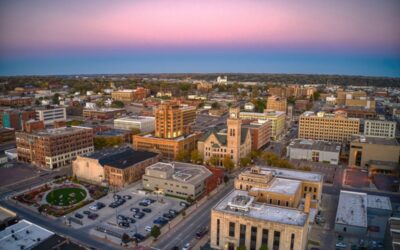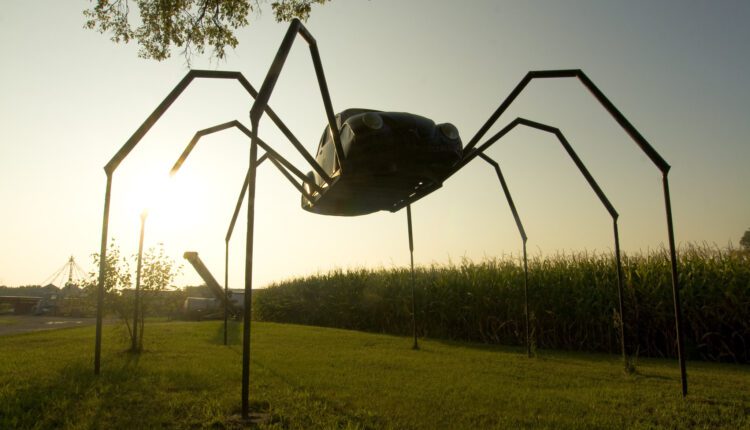
Photo courtesy of Silly America/CC BY-NC-ND 2.0.
Among the many roadside attractions in Iowa, these 12 are by far the weirdest.
Sometimes, the best part of a road trip is stopping to take in the scenery. Here in Iowa, you might also want to plan a little extra time to stop and take in some wildly weird and wonderful roadside attractions. Some are iconic. Some you may not yet know about. All of them are among the quirkiest pit stops you can make as you make your way across the state. We promise the photos you snap will be worth the drive.
1. Albert the Bull
Audubon
You’ll be sure to spot Albert, the world’s largest bull, as you approach him. He’s a Hereford bull that is nine times larger than one you’d see in real life. He boasts a 15-foot span between his horns, and it took some 65 gallons of paint to give him the distinct red and white colors of his breed. Another cool fact about Albert is that the steel frame under that cool exterior was created using old windmill pieces. He weighs in at 45 tons as he is made of concrete. Located in a park in Audubon, where there is also a playground and camper hookups, Albert has been stopping vehicles in their tracks for more than 50 years.
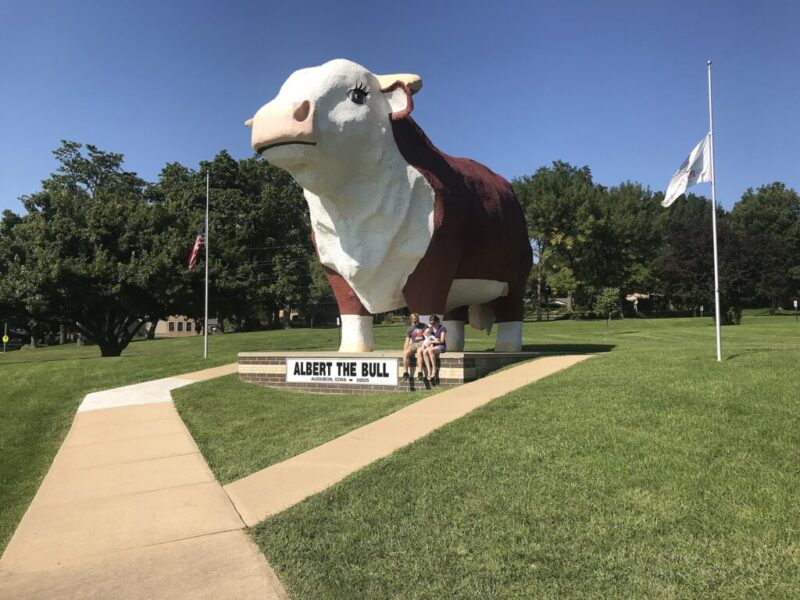
Photo courtesy of Jritchie46/CC BY-SA 4.0.
2. Spider Beetle
Avoca
If you are scared of spiders, avoid Avoca if you can. Here, just off Interstate 80 (exit 40), sitting on the lawn of a quiet residential property, you’ll find a large spider constructed from a vintage VW Beetle. One of a handful across the United States, this spider vehicle with its long, spindly legs towers some ten feet in the air. The artistic arachnid was created in the 1980s by Avoca residents and siblings Travis and Angela Campbell as a gift for their father, whose welding shop is located near the spider. Recently, it gained some company in the form of a metal dragonfly and a metal dinosaur. Keep in mind that this roadside attraction is located on personal property, so be respectful as you take your pictures.

Photo courtesy of Silly America/CC BY-NC-ND 2.0.
3. Elwood, the World’s Largest Gnome
Ames
The tour of enlarged items continues in Ames, where you can find Elwood, the World’s Largest (concrete) Gnome. (Sidenote: the world’s largest gnome resides in Poland but is made of fiberglass, so Elwood’s distinctive construction is of importance.) He calls Reiman Gardens at Iowa State University home. He was sculpted by Wisconsin artists Andy and Connie Kautza of National Rock and Sculpture, Inc in 2010. His name is a nod to the original name of University Boulevard in Ames (it was formerly Elwood Drive). Elwood the Gnome comes in at 15 feet high, and he weighs some 3,500 pounds. He happily greets visitors to the beautiful gardens he calls home.
4. Giant Garden Trowel
Des Moines
From one garden to another: In the heart of downtown Des Moines, you might notice an excessively large garden trowel. Stuck into the earth right on the campus of DotDash Meredith, this iconic work of art is a nod to the publishing giant’s roots in the gardening realm. The trowel, a whopping 23 feet tall and 2,300 pounds, was created by artists Claes Oldenburg (of the Minneapolis cherry sculpture fame) and Coosje van Bruggen. Its official name is Plantoir. Made of aluminum, fiber-reinforced plastic, and steel, it was created in 2001. Originally exhibited on the Iris and B. Gerald Cantor Roof Garden at Metropolitan Museum of Art in Manhattan, New York in 2002, then Meredith Corporation purchased the trowel in honor of the company’s 100th anniversary and had it installed near their headquarters in Des Moines where it sits—er, digs—today.
5. American Gothic House
Eldon
If you’ve seen Grant Wood’s famous American Gothic painting (arguably one of the most parodied paintings in the world), then you’ll know just the house to stop at as you drive through Eldon in south central Iowa. It’s the house that is said to have inspired that iconic painting, most notably its peaked second-floor window and simple clapboard construction. Grant Wood visited Eldon in 1930, taking note of the small home with the large Gothic window. Located on farmland just outside of Eldon, the home is now owned and operated by the State Historical Society of Iowa. Its visitor center is open at regular hours during the week, but the site is open from dawn until dusk year-round regardless if the visitor center or house is open. Many visitors stop by each year to stand out front holding a pitchfork and looking morose like the famed duo in the painting, which now lives at the Art Institute of Chicago.

Photo courtesy of photolibrarian/CC BY-NC-ND 2.0.
6. Pocahontas Princess Statue
Pocahontas
Just on the eastern edge of town, near Highway 3, you’ll find a statue of Native American Princess Pocahontas welcoming visitors and residents alike to the northwestern Iowa town. Standing over 25 feet tall, the Pocahontas statue has been a prominent landmark since first being constructed in 1956. It is officially the world’s largest Indian maiden monument. She is made of a steel and wood frame covered in concrete. Local businessman Frank W. Shaw had her created by designer W. C. Ballard, who happened to be the designer of other notable sculptures like the giant muskie and Paul Bunyan’s sweetheart in Minnesota. Princess Park, where she’s located, also includes a teepee, several beautiful murals, and a historic cabin where you can see artifacts and learn more about Pocahontas herself. However, you may be disappointed to find out that Pocahontas likely never visited Iowa during her travels.
7. Snake Alley
Burlington
This is one unique street that snakes its way up the hillside in Burlington between Columbia and Washington Streets. It was deemed “Unbelievably Crooked” and the #1 Odd Spot in Ripley’s Guide to the Curious Corners of America. It includes five half curves and two quarter curves as it races back and forth uphill at a 21 percent grade, covering a drop of 58 feet over 275 feet. First constructed in 1894, the street is made of limestone and blue clay bricks. Then, it was meant to connect the residential neighborhood at the top with the bustling commercial district below. If you plan to be in Burlington for Memorial Day, you can take part in the Snake Alley Criterium, a short but taxing bike race up the famed street. It is also the site of an art fair over Father’s Day weekend each year.
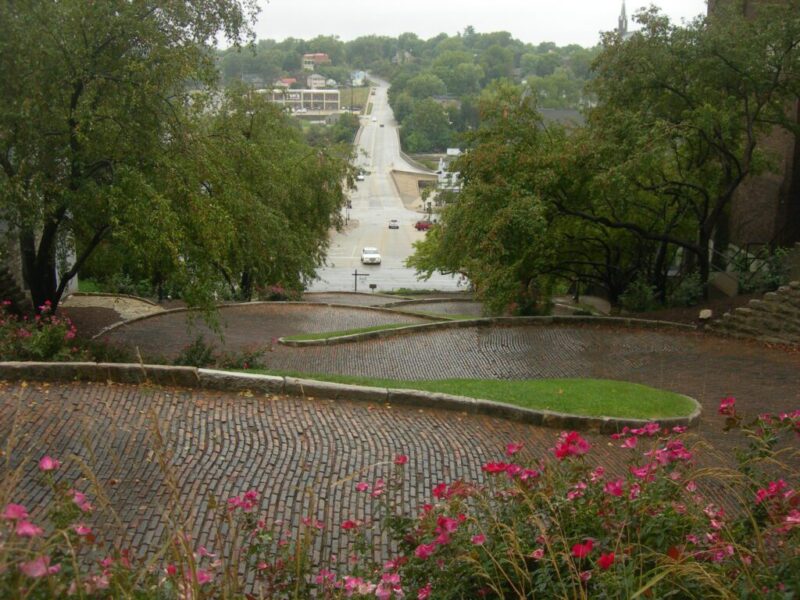
Photo courtesy of Jimmy Emerson, DVM/CC BY-NC-ND 2.0.
8. Iowa’s Largest Frying Pan
Brandon
OK, it might not be the world’s largest frying pan anymore, but this big piece of cookware located in Brandon definitely takes the prize as the largest frying pan in the state. Just imagine how many pancakes or pieces of bacon you could cook up on it! We’re getting hungry just thinking about it! Lucky for us, someone did the math. This frying pan—at nine feet wide and 14 feet tall (including the handle)—could handle cooking up 44 dozen eggs or 88 pounds of bacon. The pan was built in 2004 (modeled after a 10-inch skillet) as part of the celebration of the Cowboy Breakfast Festival. Today, it’s fun to climb up in for a photo.
9. Birthstone of Starfleet Captain James T. Kirk
Riverside
If you are a fan of Star Trek, then a trip to Riverside in southeast Iowa is a must. Here you’ll find the birthstone that marks the future birthplace of Starfleet Captain James T. Kirk. The stone, noting the future birthdate of March 22, 2228, is located in an unassuming lot but has been confirmed as valid by Star Trek creator Gene Roddenberry. The idea first came up at a city council meeting in 1985, when the town was looking for a new theme for its annual festival. Council Member Steve Miller suggested they declare Riverside the future birthplace of Captain Kirk, and the motion immediately passed. Today, Riverside is also home to TrekFest, which takes place at the end of June each year and draws many visitors and fans of the famed futuristic series.
10. World’s Largest Swedish Coffee Pot
Stanton
Make a stop in Stanton and consider grabbing a cup of coffee to sip as you visit the world’s largest Swedish coffee pot. Chosen because of its welcoming symbolism, the large Swedish coffee pot is actually a water tower serving residents of and visitors to Stanton. Of course, there’s a large coffee cup (another water tower) nearby, which was added in the 2000s. The coffee pot used to sit much higher on a tower base but has now been lowered closer to the ground, restored and sits on the site of the Swedish Heritage and Cultural Center. The coffee pot was actually created in honor of famed Stanton native Virginia Christine, who played Mrs. Olsen in historic TV advertisements for Folgers coffee in the 1960s and 1970s.
11. Buddy Holly Crash Site
Clear Lake
Some notable roadside attractions have a bleaker past, like the Buddy Holly Crash Site. The crash occurred just after midnight on February 3, 1959, when Holly and his travel companions Ritchie Valens and J.P. “The Big Bopper” Richardson died at the hands of an inexperienced pilot trying to get them to Minnesota for their next show. While there’s an official “the day the music died” memorial at the nearby Surf Ballroom, here at the crash site visitors can see a stainless steel monument with three records and a guitar, made by Ken Paquette in 1988. The site is in the middle of an Iowa cornfield. You’ll know you’ve arrived when you spot a large pair of black glasses, modeled after those Holly wore. This site is on private property as well, so make sure you visit respectfully. Many people who visit live small mementos and signs of mourning and respect for the music greats.

Photo courtesy of photolibrarian/CC BY-NC-ND 2.0.
12. Grotto of the Redemption
West Bend
You don’t necessarily need to travel overseas for a pilgrimage. Consider a pitstop at the Grotto of the Redemption in West Bend, the largest man-made grotto in the world. It is also the site of the largest collection of precious stones and gems found anywhere in the world. This holy site is made up of nine separate grottos all depicting scenes from the life of Jesus Christ. It has been referred to as the 8th Wonder of the World and a “miracle in stone.”
The grotto was designed and created by Father Paul Matthias Dobberstein, who promised to create the site as a prayer to Mary while he was fighting off pneumonia. He spent a decade collecting the rocks he’d need and began work on the grotto in 1912. He worked with several others and passed the torch on to other pastors to continue the work over the course of several decades until it arrived at today’s appearance. The total value of all the rocks and minerals featured in the grotto is well over $4 million, and some 100,000 people visit each year. It was placed on the National Register of Historic Places in 2001. The site is open 24 hours a day, seven days a week, year round—so you can stop no matter when you are traveling through. Seasonal guided tours are offered and there is a small gift shop with limited hours on site as well.
This article first appeared on Good Info News Wire and is republished here under a Creative Commons license.

Advocates want Iowans to boycott Amazon, Home Depot and Target during Black Friday
The ‘We Ain’t Buying It’ campaign hopes consumers use their wallets to hurt companies complying with ‘threats on democracy.’ Under the banner of “We...

The 8 most magical winter festivals in Iowa for 2025-2026
Iowa’s winters may be cold, but there’s plenty to warm your hands and your heart at these beautiful winter festivals across the state. The winds are...
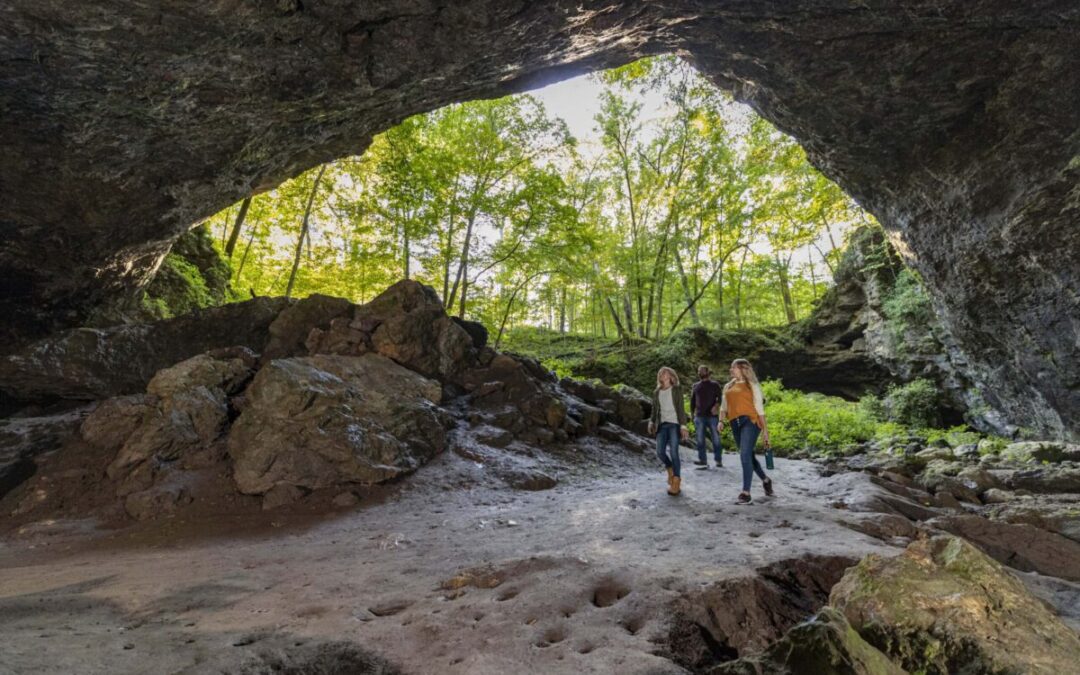
Your guide to 12 fun & frugal family outings in Iowa
Uncover 12 budget-friendly family activities in Iowa, from historic sites to natural wonders. Have fun without spending a fortune! Whether you live...

Guide to Pikes Peak State Park: Camping, hikes, fees, & more
There is plenty to do in Pikes Peak State Park, from hiking to birding to hunting for fossils. Discover one of Iowa’s top nature destinations. ...

Wander through the 8 coolest corn mazes in Iowa
The arrival of autumn means picking pumpkins, drinking apple cider, and traipsing among corn stalks. Check out these eight corn mazes in Iowa for...

2025 Iowa leaf-peeping guide: When & where to see fall colors
Fall—it’s the most colorful time of the year. Plan the perfect Iowa leaf-peeping adventure with our guide to the best places and times to see fall...





